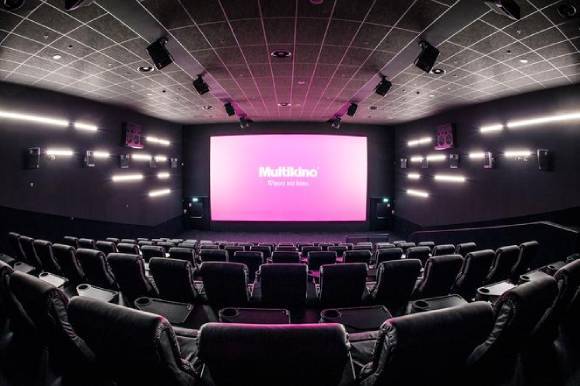Poland has over 1,200 cinema screens, of which 80% are operated by big multiplex cinema chains. The leading companies are Cinema City with over 30 multiplex cinemas, 380 screens and 110,000 seats, Helios with 42 cinemas and 49,000 seats, and Multikino with 48 cinemas and 70,000 seats. Additionally, there are more than 600 one-screen, studio cinemas.
At the end of April 2021, the Polish government announced that cinemas will be able to reopen on 29 May 2021 and then changed its decision, lifting the restrictions a week earlier on 21 May. This move was welcomed by arthouse cinemas, but not by the big players.
“The last year and a half have been a series of constant challenges, but I think we did well, since not a single studio cinema in Poland has closed for good. However, we cannot rest on our laurels. Rebuilding the position we had before the pandemic will take at least a dozen or so months, so we welcome the lifting of the restrictions,” Marlena Gabryszewska, head of the Studio Cinemas Association, told FNE.
 Multikino, also in comments to FNE, said: “We were informed that the cinemas were to be opened on 29 May this year. Our comprehensive business resumption plan was built on the date indicated at the time. We immediately communicated the above date to our viewers and business partners. Since we were informed, we held talks with film distributors in terms of preparing an attractive repertoire, both Polish and foreign, for our viewers.”
Multikino, also in comments to FNE, said: “We were informed that the cinemas were to be opened on 29 May this year. Our comprehensive business resumption plan was built on the date indicated at the time. We immediately communicated the above date to our viewers and business partners. Since we were informed, we held talks with film distributors in terms of preparing an attractive repertoire, both Polish and foreign, for our viewers.”
To aid in encouraging audiences back to cinemas, Multikino launched the Safe Return to Multikino educational campaign on 28 May 2021, advocating respect for their sanitary regime. “Research from the beginning of the pandemic shows that, despite over 100 million visits to cinemas around the world, no outbreak of the coronavirus has been found. The cinema is safer than other similar leisure facilities, because the seats in the cinema halls are allocated by the ticket system, which automatically imposes the appropriate distance; there is constant forced air exchange, and during the screening viewers sit back-to-back and do not engage in conversations; they are also obliged to cover their nose and mouth.” Dr Łukasz Durajski, Multikino’s spokesperson for the campaign told FNE.
In the meantime, Cinema City opted out of an earlier reopening, while Helios decided to open on 21 May 2021 and noted great results, reporting 56,328 tickets sold. “The big hit of the opening night was the film Godzilla vs. Kong. However, on the first weekend after the launch of the network, the most frequently chosen title was the animation Soul, which shows that there were also children waiting for the opening of cinemas. Guy Ritchie's Wrath Of A Man was second, and Mortal Kombat was third,” commented Tomasz Jagiełło, president of Helios and Agora's board member.
These testimonies corroborate the official statistics. According to the Polish Filmmakers Association, during the weekend of 4-6 June, the most popular films in cinemas were Cruella (33,141 admissions), Godzilla vs. Kong (28 671), Wrath Of A Man (18,347), Where Dreams Come From (13,556) and Soul (10,458). The most watched Polish production was The Second Half (10,086 admissions, sixth place in the ranking). These numbers point to a rise in box office attendance. However, this has been hard to track in Poland since the pandemic broke out, as a result of the fact that not all cinemas or distributors have been reporting their results.
Key players like Agora, owner of Helios, remain optimistic and determined to make up for lost time. “After the cinemas reopened on 25 May, Agora estimated the return level at 35%. Turnout in 2020 (after the first wave) was 19%. We have underestimated the extent to which Poles will want to return to the cinema,” said Tomasz Jagiełło. “In June 2020, the level of revenues  reached 110 percent vs. the same period of 2019. Of course, this is the effect of the "giant bulldozer": premiering six or seven films every week, and waiting six months for premieres. We have the effect of a popcorn starvation explosion. Sales in bars soared to levels unheard of before the pandemic. This is a much higher level than we expected before the cinemas reopened”, he continued.
reached 110 percent vs. the same period of 2019. Of course, this is the effect of the "giant bulldozer": premiering six or seven films every week, and waiting six months for premieres. We have the effect of a popcorn starvation explosion. Sales in bars soared to levels unheard of before the pandemic. This is a much higher level than we expected before the cinemas reopened”, he continued.
This upswing comes off the back of a difficult 18 months. The healthy performance of the film distribution market in Poland was interrupted in 2020, due to the coronavirus pandemic. In 2020, cinema attendance in Poland was less than 30% of that in 2019; this translated into a decrease from 60.9 m to 17.1 m admissions. The revenues amounted to less than 71.2 m EUR / 331 m PLN. In March 2020, in response to the pandemic and the dramatic situation in which the Polish film industry found itself, the Director of the Polish Film Institute Radosław Śmigulski, appointed a task force to deal with the crisis. Also in May 2020, the Studio Cinemas Association launched the largest virtual cinema in Poland, Mojeekino uniting 47 studio cinemas, where film screenings, as well as meetings with filmmakers and film festivals, took place. In October 2020, the Polish Government approved an additional 27 m EUR / 120 m PLN support from the COVID-19 Counteracting Fund to help the cinema industry.
Polish cinemas were open only for 168 days in 2020, with the last lockdown of the year implemented in October 2020 and lifted in February 2021. The reopening of cinemas was unexpectedly announced by the government. Helios did not open its cinemas in mid-February and Tomasz Jagiełło, president of Helios and Agora's board member, told FNE that, “the Helios cinema chain did not open its facilities in mid-February 2021, despite the government's decision to do so. Restarting 50 cinemas across Poland under the stringent sanitary regime is a logistically difficult and costly operation.”
As a result, after the 2020 autumn lockdown, only studio cinemas were reopened. In the first two weekends after the reopening of cinemas (12-14 and 19-21 February), over 68,000 people attended film screenings all over Poland.[1] The largest multiplex chains - such as Multikino, Cinema City and Helios - had been closed since November of 2020, since their owners were waiting for the indefinite opening of cinemas.
In the spring of 2021, the government introduced a third lockdown due to the rise in COVID-19 cases in March, resulting in cinemas, theatres and all cultural institutions being shut down on 20 March 2021. Roman Gutek, co-founder of the Gutek Film distribution company and the owner of the Muranów Cinema in Warsaw, commented that while he understood the return to restrictions and the fight to limit the spread of the virus, he didn’t appreciate the way they were introduced. “At the beginning of February 2021, information about the temporary opening of cinemas was announced a week in advance. This is not a serious approach. What if the cinemas were opened when there was nothing to show in them? The offer was very modest. Distributors are not able to prepare films in such a short time. They also need time to promote them. The opening of cinemas must preferably be announced two months in advance,” he told FNE.
 Relief came in May 2021, when the government decided that open-air cinemas could be put into operation from 15 May and all cinemas could open on 29 May 2021. Both types of cinemas could be filled up to 50% of their capacity, in accordance with a strict sanitary regime. It is worth mentioning that the COVID-19 pandemic brought about a revival of drive-in cinemas. To meet the needs of audiences, several companies decided to open drive-in cinemas both locally and on the national scale. Two new brands led the way: Auto Cinema opened branches in most major Polish cities in May 2020; Movie Drive is a similar initiative, which launched drive-in cinemas in over 40 locations all around Poland, including Warsaw, Gdańsk, Katowice and Poznań. Traditional outlets also organised outdoor screenings. Ticket prices ranged from 7.6 to 8.7 EUR / 35 to 45 PLN per car.
Relief came in May 2021, when the government decided that open-air cinemas could be put into operation from 15 May and all cinemas could open on 29 May 2021. Both types of cinemas could be filled up to 50% of their capacity, in accordance with a strict sanitary regime. It is worth mentioning that the COVID-19 pandemic brought about a revival of drive-in cinemas. To meet the needs of audiences, several companies decided to open drive-in cinemas both locally and on the national scale. Two new brands led the way: Auto Cinema opened branches in most major Polish cities in May 2020; Movie Drive is a similar initiative, which launched drive-in cinemas in over 40 locations all around Poland, including Warsaw, Gdańsk, Katowice and Poznań. Traditional outlets also organised outdoor screenings. Ticket prices ranged from 7.6 to 8.7 EUR / 35 to 45 PLN per car.
Several cinema lovers turned to home entertainment to survive the unavailability of the big screen. On-demand services became more popular in Poland during the COVID-19 pandemic. According to the November IRCenter report Multiscreening 7, World of New Media, as much as 74% Poles paid for VoD content in 2020, while in 2019 the percentage was only 44%. In the 15-24 age group, the percentage is 82%, with the most preferred form (by 57%) being monthly packages. According to the Mediapanel study by Gemius / PBI, Netflix has become a clear leader in 2020, with nearly seven million users in Poland in January 2021.
Looking ahead, Helios’ Jagiełło refuted the idea that cinema operators in Poland are afraid of the rise in VOD’s popularity in Poland, “I strongly deny that there are wars between streaming platforms and cinemas; we are dealing only with a fight between platforms to get a position for the future. It is commonly said that more than three of them will not survive. We have a period when platform owners make great investments, that is, they probably pay more for films than it is worth, to show everyone the superiority of their offer.”
[1] Source: Boxofficemojo.com
The 2021 Year of Recovery for Film in Visegrad Countries (YR2021) project brings together filmmakers and cultural professionals across the V4 to cooperate in the recovery of the film industry which has been badly damaged by the COVID pandemic and to reconnect with cinema audiences across the region and across borders. We want to share the lessons learned about reaching audiences online and the advantages of hybrid events in creating new connections across the Visegrad region.




















